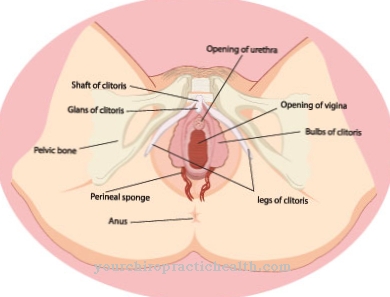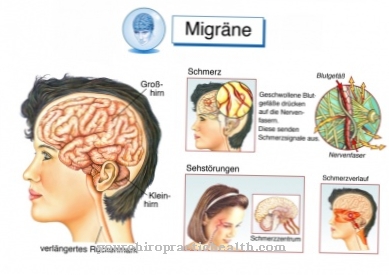The bones, based on their extremely remarkable structure, are extremely resilient and even flexible to a certain extent. This is ensured by the stored organic and inorganic substances and the bar-like nature of the bones. Still, these benefits don't always protect against one Tibial head fracture or in front of a Broken tibia.
What is a tibial head fracture?

© SciePro - stock.adobe.com
The medical term Tibial head fracture is made up of several parts of the word. The tibia is the shin bone, which is located at the front of the lower leg. A fracture refers to a broken bone.
The tibial head is a special anatomical area of the tibia, which is thickened and represents the transition to the joint. The tibial head is also called the caput tibiae in precise medical terminology.
A tibia fracture is therefore usually an injury. The fracture of the tibial head is a very common trauma that requires intensive treatment and, under certain circumstances, can cause consequential damage and complications.
causes
The causes of a Tibial head fracture are mostly due to the action of mechanical forces, which primarily occur suddenly and unexpectedly. These are mainly falls and legs hitting an unyielding surface from a great height.
A tibial head fracture can also be caused by internal triggers. These relate to prior damage to the bone structure due to the infiltration of a tumor into the weakening of the bone substance associated with it, as well as to existing osteoporosis. The bone loses its stability and a fracture of the tibial head can result.
If it is caused by permanent overload, a fracture of the tibial head cannot be ruled out either. Tibial head fractures occur predominantly as sports or accidental injuries or arise from unsecured activities in private households.
Symptoms, ailments & signs
In a tibial head fracture, the tibial head is broken. Accordingly, complaints mainly occur in the knee and lower leg area. Externally there is a swelling there. Patients complain of severe pain that occurs even when they are touched.
Bruises also occur regularly. A fracture of the tibial head inevitably leads to restricted mobility. Those affected can only walk with pain and have to be supported. Simply getting up from a sitting or lying position causes problems. Patients sometimes need help with everyday tasks, such as going to the toilet or getting up in the morning.
Only after a few weeks of healing can the joint be used again without discomfort. The fracture at the head of the tibia rarely occurs alone. The cruciate ligament and collateral ligament are usually injured as a result of an accident. Even the meniscus, which acts as a shock absorber in the knee joint, can be damaged. It is therefore important that the healing is accompanied by an expert.
Therapists are regularly involved. If the fracture of the tibial head is not completely healed, permanent sensory disorders will also result. Some patients report paralysis or sensitivity to the weather. Osteoarthritis can develop. If sick people adopt a relieving posture and place excessive strain on the other tibial head, permanent physical malpositions can occur.
Diagnosis & course
There one Tibial head fracture can occur in different areas of the lower leg, varying symptoms are also perceived. The tibial head fracture in all tibial areas is the same, however, in that enormous painful discomfort occurs.
Those affected also notice a tibial head fracture due to swelling of the tibia. It is not possible to stand up independently after a tibial head fracture. In addition, the tibia has lost all of its resilience after a tibial head fracture. The lower leg shows an abnormal shape. Bruises and twisting as well as deviations in shape represent a tibia fracture.
The diagnosis and differential diagnosis of a tibial head fracture include a scan and a movement test by the doctor. Computed tomography or magnetic resonance tomography and an x-ray are also popular. Doppler sonography is also used if a tibial head fracture is suspected.
Complications
Different complications can arise due to a fracture of the tibial head. The break is often associated with impairment of the cruciate ligament, inner ligament or outer ligament in the knee. The meniscus is also not infrequently affected, which occurs through splintered bone parts. There is a risk of osteoarthritis of the knee joint years after the injury.
To counteract this unpleasant sequelae, surgical treatment is usually carried out. Injuries to the arteria politea, the artery of the hollow of the knee, are also among the possible complications of the tibial head fracture, which is usually the case with a debris fracture. In contrast, involvement of the nerves rarely occurs.
However, damage to the fibular nerve is possible with an accompanying fracture of the fibular head. A comminuted fracture or an impression fracture (indentation fracture) are often responsible for knee osteoarthritis. Arthritis occurs due to an imprecise reduction of the joint surface.
The compartment syndrome is also one of the conceivable effects of a fracture of the tibial head. As a result of the injury, the muscles swell. Within the lower leg, the muscles are located in several compartments or fascia. If swelling occurs within these closed areas, the muscles no longer have room to expand. This results in the blood supply being clamped off.
Because the tissue is only insufficiently supplied with blood, it threatens to die. Wound healing disorders can occur after surgical treatment of the tibial head fracture. This risk is particularly high if the intervention is performed too early. An infection is also possible, which makes it difficult for the fracture to heal.
When should you go to the doctor?
If severe pain occurs in the limb area after a fall, an accident or violence against the body, a doctor should be consulted. If the symptoms persist or if they increase in intensity, the person concerned needs an extensive examination for a diagnosis.Restrictions on movement, a decrease in the physical capacity and discoloration of the skin must be presented to a doctor. If there are bruises or visual changes in the lower legs or knee, these are causes for concern.
If the knee joint cannot be bent as usual, if there are changes in the movement sequences or if the affected person needs help with locomotion, a doctor should be consulted. Sensitivity disorders, a tingling sensation on the skin or irregularities in the blood flow should also be examined. These are signs of a health disorder that needs treatment.
If the daily obligations can no longer be fulfilled independently, if gait insecurities are evident or behavioral problems are present, it is advisable to consult a doctor. Paralysis, a sensitivity to the weather, a protective posture of the body or impairments of the muscular system must be presented to a doctor. Without medical care, there is a risk of consequential or irreparable damage to the skeletal system. If the person concerned is unable to pursue normal sporting activities due to their symptoms, they should consult a doctor.
Treatment & Therapy
Treating a Tibial head fracture includes conservative therapy without surgery or surgical straightening of the fracture. In the first variant of the treatment of a tibial head fracture, the fracture areas are relocated back to their natural position (reduction) and stabilized by a plaster cast, an external fixator or a fixed splint.
In order to avoid muscle wasting due to prolonged immobilization, physiotherapy therapy can be carried out after a certain period of time.
If the tibial head fracture shows a complicated picture, an operative method is used. This includes the insertion of an intramedullary nail and the introduction of special holding plates. The cross bolts or locking systems have also proven themselves in surgical treatment. These are selected if there are so-called debris and twist fractures or if the fracture is in the immediate vicinity of the joint.
Different components are also selected for cleft and compression fractures. These stabilizations are compatible with the body and can remain on the bone for a longer period of time. Surgical treatment of a fractured tibial head does not always require general anesthesia.
prevention
To a Tibial head fracture and to avoid its consequences, it makes sense to recognize excessive strain on the lower extremities in good time in order to eliminate the risk of an overtired fracture. In all practical activities at great heights, sufficient safety should always be ensured in order not to suffer any broken bones in the event of a fall. Since tibial head fractures often occur during exercise, the muscles must be warmed up accordingly in order to reduce the risk of fracture.
Aftercare
Follow-up care is required for both conservative and surgical treatment of the tibial head fracture. It consists primarily of physiotherapeutic measures. These help the patient to regain his or her usual mobility after the tibia head has been immobilized for a long time. It usually takes two to three months before physiotherapy exercises can be started.
In the course of the follow-up treatment, the loads are increased step by step. In this way, excessive strain on the tibial head can be avoided. The follow-up care of a fractured tibial bone requires a lot of patience from the patient. The fracture will roughly heal again after around eight to twelve weeks. It can take up to another six weeks before the person concerned can move fully again.
The healing process can be accelerated by the patient. To do this, he should only put as little weight as possible on his knee. In an emergency, assistants can also be used, but this should be done rarely due to the pressure loads.
After surgical treatment of the tibial head fracture, the patient is given pain reliever medication. Pain therapy is considered extremely important, as otherwise chronic pain symptoms threaten. During an operation, the removal of the screws or plates used can also be part of the follow-up care. Surgical removal depends on the age of the patient and whether the metal parts cause discomfort.
You can do that yourself
A tibial head fracture requires immediate medical treatment. Self-help measures are not indicated in the case of bone fractures immediately after the fracture. In the absence of medical treatment or if therapy is started too late, the risk of permanent damage and severe mobility restrictions, which can last a lifetime, increases.
Patients with a fractured tibial head support the medical treatment by following the instructions of the doctors regarding physical restraint and avoiding certain movements or even sport. In addition, people with a fractured tibial head attend all medical check-ups. While the bandage is on the leg, the patients especially avoid physical stress. After the doctor has removed the bandage, the patient can use scar care to promote the healing of the scar and achieve the most aesthetic result possible.
Those affected refrain from vigorous physical activity as long as the attending doctor prescribes it. After that, the leg must gradually be used to exercise again. For this purpose, the patients with tibial head fractures usually visit physiotherapy and learn suitable training exercises. Those affected also do this in their own four walls. Shoe insoles can also be prescribed after the fracture to support the skeleton and muscles and prevent bad posture.

.jpg)
.jpg)











.jpg)
.jpg)











.jpg)